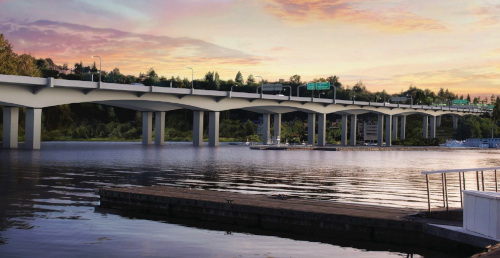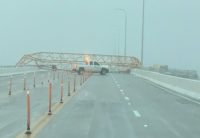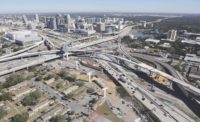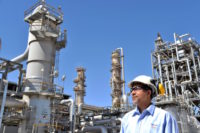The $1.4-billion rebuild of Seattle’s Portage Bay Bridge to meet current seismic resiliency standards was awarded to Skanska by the Washington State Dept. of Transportation (WSDOT) last month.
Skanska’s design-build agreement with the WSDOT covers replacing the aging Portage Bay Bridge and building a landscaped lid over the highway that will connect the Roanoke Park and North Capitol Hill neighborhoods. The agency expects construction to begin later this year and be completed by 2030.
“Skanska is excited to deliver this critical piece of infrastructure,” said James Bailey, executive vice president of Skanska USA Civil’s West Coast operations, noting that the bridge replacement is “an important piece of broader improvements to the SR 520 corridor, one of the busiest across the Puget Sound region.”
The project is part of WSDOT’s $5.69-billion SR 520 Replacement and HOV Program that will reconstruct the entire corridor from Interstate 405 in Bellevue to I-5 in Seattle when completed in 2032. The Portage Bay Bridge portion will complete the program’s transit and HOV enhancements between Redmond and Seattle.
The four-lane bridge over Portage Bay, which was built in the 1960s, is supported only by hollow concrete columns, making it vulnerable to collapse in a severe earthquake. It will be replaced by two parallel, seismically stronger bridges. The eastbound bridge span will extend the regional bicycle and pedestrian SR 520 Trail across the bay, connecting to Seattle’s non-motorized trail network.
Two bids for the project were received last summer, with Skanska’s $1.73-billion bid being determined the best value in September. The firm’s offer was about 72 percent higher than the state engineer’s estimate and $300 million below that of rival Kiewit/Stacy and Witbeck.
Because of the funding gap, the state initially stopped short of awarding the contract. But Skanska agreed to extend the expiration date and was awarded the contract on March 11.

The Portage Bay Bridge reconstuction is scheduled for completion in 2030.
Rendering courtesy WSDOT
Amid a state budget crunch, that shortfall prompted legislators to order WSDOT to “seek consequential cost reduction opportunities through value engineering and prioritizing functionality and usability of the Portage Bay Bridge and Roanoke Lid,” with a report on closing the funding gap due to the legislature by mid-December.
“This process will enable us to reduce some costs and mitigate potential future cost risks (e.g. escalation and inflation),” said Shoshana Wineburg, a WSDOT spokesperson.
She added that the value engineering process will “assess all elements of the project, including bike and pedestrian elements, and determine where we can maintain function and also reduce cost, time and risk.”
WSDOT has reportedly looked at a number of cost-cutting options, including initially just building the twin Portage Bay bridges and leaving the Roanoke Lid until later, building just the north bridge and building the south bridge and lid later, and just replacing the north bridge and then pausing the entire project.
However, Wineburg said any refinements “will not remove key parts of the project’s purpose: replacing vulnerable bridges, improving safety, enhancing regional mobility and providing new and better options for non-motorized travel.”
“The lid is a major element of the project’s scope and purpose and will not be removed from the project,” she added.





Post a comment to this article
Report Abusive Comment